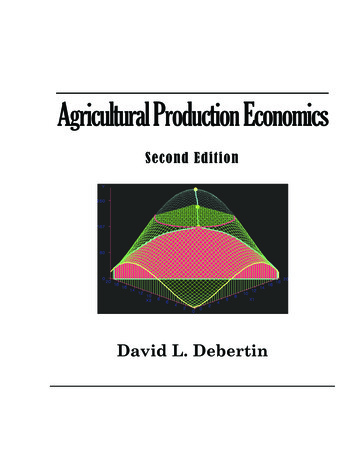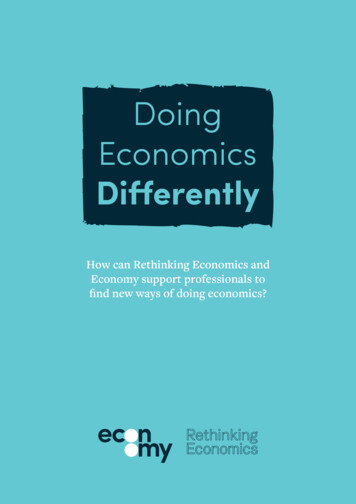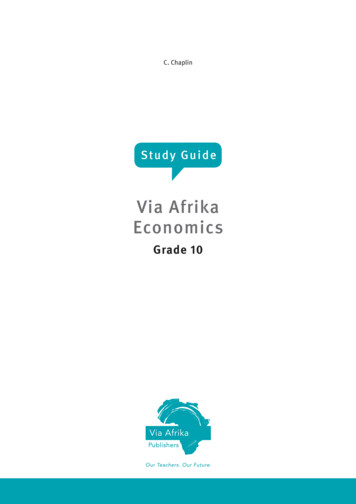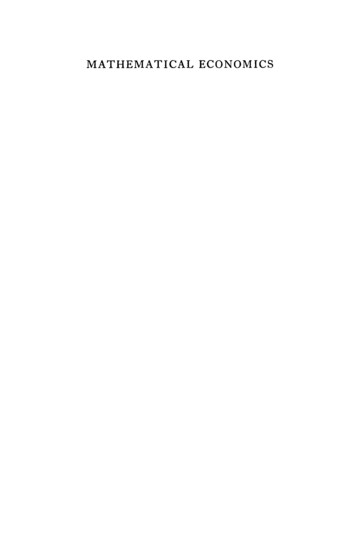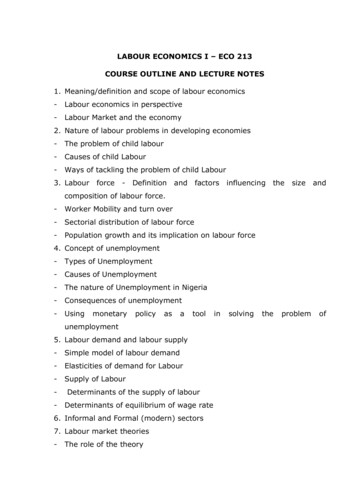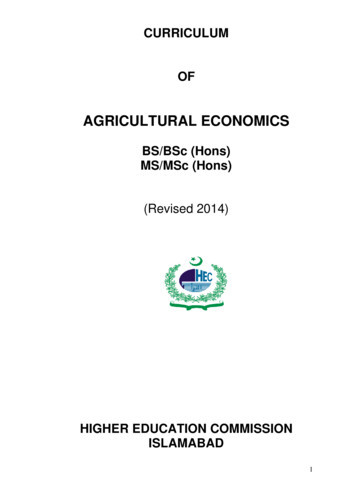
Transcription
CURRICULUMOFAGRICULTURAL ECONOMICSBS/BSc (Hons)MS/MSc (Hons)(Revised 2014)HIGHER EDUCATION COMMISSIONISLAMABAD1
CURRICULUM DIVISION, HECProf. Dr. Mukhtar AhmedChairman, HECMr. Fida HussainDirector General (Acad)Mr. Rizwan ShoukatDeputy Director (Curri)Mr. Abid WahabAssistant Director (Curri)Mr. Riaz-ul-HaqueAssistant Director (Curri)Composed by: Mr. Zulfiqar Ali, HEC, Islamabad2
CONTENTS1. Introduction62. Standardized Scheme of Studies forBS/BSc (Hons)93. Scheme of Studies for BS Agricultural Economics104. Semester-wise (Scheme of Studies)115. Detail of Courses126. Scheme of Studies for MS/MSc (Hons)307. Detail of Courses318. Details of Compulsory CoursesAnnexures – A, B, C, D, E449. Recommendations663
PREFACEThe curriculum, with varying definitions, is said to be a plan of the teachinglearning process that students of an academic programme are required toundergo. It includes objectives & learning outcomes, course contents,scheme of studies, teaching methodologies and methods of assessment oflearning. Since knowledge in all disciplines and fields is expanding at a fastpace and new disciplines are also emerging; it is imperative that curriculabe developed and revised accordingly.University Grants Commission (UGC) was designated as the competentauthority to develop, review and revise curricula beyond Class-XII videSection 3, Sub-Section 2 (ii), Act of Parliament No. X of 1976 titled“Supervision of Curricula and Textbooks and Maintenance of Standard ofEducation”. With the repeal of UGC Act, the same function was assigned tothe Higher Education Commission (HEC) under its Ordinance of 2002,Section 10, Sub-Section 1 (v).In compliance with the above provisions, the Curriculum Division of HECundertakes the revision of curricula after every three years throughrespective National Curriculum Revision Committees (NCRCs) whichconsist of eminent professors and researchers of relevant fields from publicand private sector universities, R&D organizations, councils, industry andcivil society by seeking nominations from their organizations.In order to impart quality education which is at par with internationalstandards, HEC NCRCs have developed unified templates as guidelines forthe development and revision of curricula in the disciplines of BasicSciences, Applied Sciences, Social Sciences, Agriculture and Engineeringin 2007 and 2009.It is hoped that this curriculum document, prepared by the respectiveNCRC’s, would serve the purpose of meeting our national, social andeconomic needs, and it would also provide the level of competencyspecified in Pakistan Qualification Framework to make it compatible withinternational educational standards. The curriculum is also placed on thewebsite of HEC (www.hec.gov.pk).(Fida Hussain)Director General (Academics)4
CURRICULUM DEVELOPMENT CONSIDERATICURRI. INDRAFT STAGEFINAL STAGEFOLLOW UPSTUDYCOLLECTIONOF RECAPPRAISAL OF 1STDRAFT BY EXP. OFCOL./UNIVPREP. OFFINAL CURRI.QUESTIONNAIRECONS. OF CRC.FINALIZATION OFDRAFT BY CRCINCORPORATIONOF REC. OF V.C.C.COMMENTSPREP. OFDRAFT BYCRCAPPROVAL OFCURRI.BYV.C.C.PRINTING OFCURRI.REVIEWIMPLE.OFCURRI.BACK TOSTAGE-IAbbreviations Used:CRC. Curriculum RevisionCommitteeVCC. Vice Chancellor’sCommitteeEXP. ExpertsCOL. CollegesUNI. UniversitiesPREP. PreparationREC. RecommendationsORIENTATIONCOURSES5
INTRODUCTIONIn continuation of earlier meeting of National Curriculum RevisionCommittee (NCRC) in the discipline of Agricultural Economics held onNovember 6-8, 2013 at HEC Regional Centre, Lahore, final meeting washeld on February 10-12, 2014 at Higher Education Commission, RegionalCentre, Peshawar. Following attended:Prof. Dr. Munir Ahmad,Joint Director,Pakistan Institute of Development Economics,Islamabad.ConvenerProf. Dr. Munir KhanDepartment of Agricultural & Applied Economics,University of Agriculture, PeshawarMemberDr. Umar Farooq,Director General/CSOPakistan Agriculture Research Council (PARC),Social Sciences Division, PARC, 20-AttaturkAvenue, G-5/1, P.O. Box 1031, Islamabad.Prof. Muhammad Ashfaq,Professor/DirectorInstitute of Agricultural & Resource Economics,University of Agriculture, Faisalabad.Prof. Dr. Zahoor ul Haq,Faculty of Social Sciences,Abdul Wali Khan University, Mardan.Dr. Gobind M. Herani,Dean / Professor,Faculty of Management Sciences,Khadim Ali Shah Bukhari Institute of Tech,84-B, SMCHS, Karachi.Dr. Ikram Ali MalikAssociate Professor,Department of Agricultural Economics,PMAS Arid Agriculture University, RawalpindiMr. Nadeem Anwar,Assistant Professor/Incharge,Department of Agricultural Economics,University College of Agriculture,University of Sargodha, Sargodha.MemberMemberMemberMemberMemberMember6
Dr. Sultan Ali Adil,Associate Professor,Institute of Agricultural & Resource Economics,University of Agriculture, Faisalabad.Dr. Habibullah Magsi,Assistant Professor,Department of Agricultural EconomicsSindh Agriculture University, Tandojam.Dr. Dilawar Khan,Assistant Professor,Department of Economics,Kohat University of Science & Technology, Kohat26000,Dr. M. Niamat Ullah Babar,Assistant Professor / ChairmanDepartment of Agricultural Economics,Gomal University, Dera Ismail Khan, KhyberPaktunkhwa.Dr. Syed Muhammad Khair,Assistant Professor,Department of Economics,Balochistan University of IT & ManagementSciences,Airport Road, Baleli, Quetta.Dr. Muhammad Rafiq,Assistant Professor,Department of Economics,Institute of Management Science,1-A, Sector E-5, Phase ayatabad,Dr. Dawood Jan,Associate Professor / Chairman,Department of Agricultural & Applied Economics,University of Agriculture, Peshawar.Secretary/MemberMeeting started with recitation from the Holy Quran by Mr. Abid WahabAssistant Director Curriculum. Mr. Zaheer Ahmed Awan, Regional DirectorHEC Peshawar welcomed the participants and briefed them about the effortsof the Commission in revision and development of curricula. Mr. Abid Wahab,Assistant Director Curriculum, HEC, Islamabad explained the procedure forcurriculum revision.7
Prof. Dr. Munir Ahmad, Joint Director, Pakistan Institute of DevelopmentEconomics, Islamabad and Dr. Dawood Jan, Associate Professor / Chairman,Department of Agricultural & Applied Economics, University of Agriculture,Peshawar were unanimously elected as Convener and Secretary,respectively.After detailed deliberations, the committee agreed and recommended thefollowings:1. Reviewed, revised and added/dropped the courses, their contentsand recommended books and suggested changes in their contents,texts as well as reference books accordingly.2. In addition the committee revised earlier scheme of studies andspecifically recommended incorporation of two courses each ofMicroeconomics, Macroeconomics and Econometrics at BS/BSc(Hons) Agricultural Economics level.3. The committee developed the courses of “Economics of ClimateChange” and “Ecological Economics”, and incorporated these asoptional courses at BS/BSc (Hons) Agri. Economics.4. The committee modified the course contents of ”, “Macroeconomics–I”, “Macroeconomics–II”,“Food and Agricultural Marketing”, “Agricultural ProductionEconomics”, “Research Methods in Social Sciences” and “Agriculturalissues and Policies of Pakistan”.5. Similarly the committee reviewed the scheme of studies for MS/MSc(Hons) in Agricultural Economics and slashed the number of corecourses from eight to six.6. The committee developed the courses of “Financial Economics”,“Pakistan Economy”, “Economics of Climate Change” and “Timeseries Analysis” at MS/MSc(Hons) level and incorporated these asoptional subjects.7. Similarly the committee recommended the inclusion of “MathematicalEconomics” as a core course and “Marketing and International Trade”as optional course.8. The committee also recommended “Mathematical Programming” asan optional course.9. Specifically, the committee identified and recommended TEXTBOOKS: and SUGGESTED READINGS: for each and every courseaccordingly.The meeting ended with a vote of thanks to and from the convener.8
Standardized Scheme of Study for 4-YearBS/BSc (Hons) AgricultureMathematics / BiologyStatistics 1 & 2Computers / ITPak StudiesIslamic StudiesCommunications SkillsEnglishBasic AgricultureSub-Total6 (3-0) (2-1) Credits6 (3-0) (3-0)3 (2-1)2 (2-0)2 (2-0)3(3-0)3(3-0)3(2-1)28One subject from each of the following disciplinesAgronomyPlant Breeding & GeneticsEntomologyPlant PathologyFood TechnologyHorticultureSoil SciencesAgricultural EconomicsSub-Total3 (2-1)3 (2-1)3 (2-1)3 (2-1)3 (2-1)3 (2-1)3 (2-1)3 (2-1)24Supporting Courses (6-8 courses (3 Cr. Hr) amongst belowAgriculture ExtensionForestry & Range ManagementAnimal ScienceAgri Business and TradeRural DevelopmentHuman NutritionAgriculture ChemistryAgriculture EngineeringWater ManagementSub Total18-24Sub-total during the first four semesters70 – 76Semester 5, 6, 7 & 8Internship/Project56-6004Grand Total:130 - 1409
SCHEME OF STUDIESFOR BS/BSc (HONS).AGRICULTURAL ECONOMICSVision:To achieve food security, and competitive and sustainable agriculturaldevelopment by providing qualified professionals of agricultural economics tocontribute in various national as well as international organizations for thepurpose.Program ObjectivesThe BSc Honors degree (Agricultural Economics) aims at equipping thestudents with the knowledge and skills required to analyze the agriculturaleconomic issues for efficient use of scarce resources in agriculture sector andits development, consistent with the interest of all stake holders.Course TitleCredit HoursIntroduction to Agricultural EconomicsAgribusiness & TradeMicroeconomics – IMacroeconomics – IMathematics for EconomistsStatistical Methods for Social SciencesFood and Agricultural MarketingMicroeconomics –IIMacroeconomics – IIAgricultural FinanceMathematical EconomicsAgribusiness ManagementEconometrics – INatural Resource EconomicsDevelopment EconomicsAgricultural Production EconomicsResearch Methods in Social SciencesEconometrics – IIAgricultural issues and Policies of PakistanInternship / -0)3(2-1)3(2-1)3(3-0)4(4-0)Optional Courses*Islamic EconomicsEconomics of Livestock ProductionAgriculture & Rural DevelopmentEconomics of Agro based IndustriesEconomics of Rangeland and PasturesEconomics of Climate Change3(3-0)3(3-0)3(3-0)3(3-0)3(3-0)3(3-0)10
Ecological EconomicsOperations ResearchLogic and Critical thinkingInternational Economics3(3-0)3(3-0)(3-0)3(3-0)*These are a few examples, Universities could develop related courseas optional course.SEMESTER WISE SCHEME OF STUDIESFORBS/BSc (Hons)Agricultural EconomicsGeneral Courses(1st to 4th Semester)Course TitleIntroduction to Agricultural EconomicsCredit Hours3(3-0)Agribusiness & Trade3(3-0)Major Courses(Fifth Semester)Course TitleMicroeconomics – ICredit Hours3(3-0)Macroeconomics – I3(3-0)Mathematics for Economists3(3-0)Statistical Methods for Social Sciences3(2-1)Food and Agricultural Marketing3(3-0)Optional3(3-0)Total Credit Hours18(17-1)(Sixth Semester)Course TitleMicroeconomics –IIMacroeconomics – IIAgricultural FinanceMathematical EconomicsAgribusiness ManagementOptionalTotal Credit HoursCredit 1
(Seventh Semester)Course TitleEconometrics – INatural Resource EconomicsDevelopment EconomicsAgricultural Production EconomicsResearch Methods in Social SciencesOptionalTotal Credit HoursCredit Eighth Semester)Course TitleEconometrics – IIAgricultural issues and Policies of PakistanInternship / ProjectTotal Credit HoursCredit Hours3(2-1)3(3-0)4(0-4)10(5-5)Optional Courses*Course TitleIslamic EconomicsEconomics of Livestock ProductionAgriculture & Rural DevelopmentEconomics of Agro based IndustriesEconomics of Rangeland and PasturesEconomics of Climate ChangeEcological EconomicsOperations ResearchLogic and Critical ThinkingInternational EconomicsCredit -0)3(3-0)3(3-0)DETAIL OF COURSESFORBS/BSc (HONS) AGRICULTURAL ECONOMICSINTRODUCTION TO AGRICULTURAL ECONOMICS3 (3-0)After completing the course, students will develop understanding of thebasic concepts of Economics and their application in agriculture.Definitions and overview of Economics and related terms; Subject matter &scope; Theory of consumer behavior; Scale of preferences; Utility,Indifference Curve & related concepts; Demand & Supply analysis; Elasticityof Demand and Supply; Market Equilibrium. Production, Factors of12
Production, laws of return and their significance in agriculture.Concept of macroeconomics; approaches to national income estimation;Growth, Unemployment & Inflation. Important macroeconomic issues inagriculture sector of Pakistan.TEXT BOOKS:1. Penson, J. B., Capps O. Rossen C. P., & Woodward, R. (2013).Introduction to Agricultural Economics. 5th Edition. New Jersey: PrenticeHall.2. Samuelson, P. A., & Nordhaus, W. D. (2009). Economics. 19th Edition.New York: McGraw-Hills.3. McConnel, C.R; Brue, S.L and Flynn, S.M. (2011). Economics: Principles,Problems and Policies 19th Edition. New York: McGraw-Hills.SUGGESTED READINGS:1. Mankiw, N. Gregory. (2011). Principles of Economics. 5th Edition. Mason:South-Western Cangage learning Publisher.2. Cramer, G., Jensen C. W., & Southgate, D. D. (2001). AgriculturalEconomics and Agribusiness. 8th Edition. Wiley Publisher.3. Pakistan, Government of.Economic Survey of Pakistan (VariousIssues), Economics Advisor Wing, Ministry of Finance, Government ofPakistan.AGRIBUSINESS AND TRADE3(3-0)After completing the course, students will be well equipped with thebasic concepts of Agribusiness and Trade.Definition, concepts, important features and scope of AgribusinessManagement, Elements and Functions of Management; Forms of businessorganizations; Agribusiness financial management; Agricultural Marketing;Marketing channels, functionaries and margins. Role of agri. marketing ineconomic development; Agricultural marketing problems.The changing world and interdependence; Basis of trade; gains from trade;Concept of absolute and comparative advantage; pattern of trade; Briefintroduction of major trade agreements.TEXT BOOKS:1. Kohls, R.L., UhI, J.N. & Hurt, C. (2007). Marketing of Agricultural Products.10th Edition. New Jersey: Prentice Hall.2. Salvatore, D., (2007) International economics. 9th Edition. Wiley Publisher.SUGGESTED READINGS:1. Hoekman, B. M., Mattoo, A., & English, P. (2002) Development, Trade andthe WTO-A Hand Book. Washington D.C: The World Bank.2. Downey, W.D. & Erickson, S. P. (2002). Agribusiness Management.Singapore: McGraw-Hill Education.13
MICROECONOMICS – I3(3-0)After completing the course, students will be able to understandeconomic issues pertaining to households and firms.Scope of Economics; Theory of Consumer’s Behaviour – Approaches to Utilityanalysis. Laws of Demand and Supply; Various dimensions of Elasticity ofDemand and Supply; Theory of Production; Cost concepts in the short run andlong run; Market equilibrium analysis.TEXT BOOKS:1. Nicholson, W. & Snyder C. M. (2009). Intermediate Microeconomics andits application. 11th Edition. Mason: South-Western Cengage learningPublisher.2. McConnel, C.R., Brue, S.L. & Flynn, S.M. (2011). Economics: Principles,Problems and Policies 19th Edition. New York: McGraw-Hills.SUGGESTED READINGS:1. Varian, H.R. (2009). Intermediate Microeconomic, 8th Edition. New York:W.W. Norton Company inc.2. Pindyck, R. & Daniel, R. (2012). Microeconomics, 8th Edition, PrenticeHall publisher.3. Leftwich, R. H. & Eckert, R. H. (1989). The Price System and Resourceallocation, 10th Edition, Islamabad, Pakistan: National Book Foundation.MICROECONOMICS - II3(3-0)The course intends to provide further insight about price and outputdetermination under various market scenarios.Characteristics and output/price determination under pure competition,monopoly, monopolistic competition and oligopoly; profit maximizationunder different market structures in both short run and long runperspectives. Price discrimination, regulation of monopoly. Game theory.Resource Market structure, demand and supply pattern in resource market(wage, rent, interest and profit determination). General equilibrium model.Welfare Economics, public goods and externalities. Microeconomics ofGovernment.TEXT BOOKS:1. Nicholson, W. & Snyder C. M. (2009). Intermediate Microeconomics andits application. 11th Edition. Mason: South-Western Cengage learningPublisher.2. McConnel, C.R., Brue, S.L., & Flynn, S.M. (2011). Economics: Principles,Problems and Policies 19th Edition. New York: McGraw-Hills.SUGGESTED READINGS:1. Varian, H.R. (2009). Intermediate Microeconomic, 8th Edition. New York:14
W.W. Norton Company inc.2. Pindyck, R., & Daniel, R. (2012). Microeconomics, 8th Edition, PrenticeHall publisher.3. Leftwich, R. H. & Eckert, R. H. (1989). The Price System and Resourceallocation, 10th Edition, Islamabad, Pakistan: National Book Foundation.MACROECONOMICS – I3(3-0)After completing the course, students are supposed to havefundamental knowledge of economic issues at aggregate level.An introduction to Macroeconomics and the economy. Microeconomics versusmacroeconomics. The roots of macroeconomics. Structure of economy andcircular flow of income. Measuring domestic output and national income.Product, expenditure and income approaches. Other national incomeaccounts. Price indices, nominal and real GDP. Economic growth andinstability: the business cycles, unemployment and its types, inflation and itstypes. The income consumption and income saving relationships, the realinterest rate and investment relationship. The multiplier, accelerator and supermultiplier effect; The aggregate expenditure model.TEXT BOOKS:1. McConnel, C.R., Brue, S.L and Flynn, S.M. (2011). Economics: Principles,Problems and Policies 19th Edition. New York: McGraw-Hills.SUGGESTED READINGS:1. Dornbusch, R., Fischer, S. and Startz, R. (2013) Macroeconomics, 12thEdition, New York: McGraw-Hill.2. Shapiro E. (2003). Macroeconomic Analysis, 5th Edition. HARCOURTBRACE publisher.3. Abel, B. Andrew & Ben S. Bernanke. (2005). "Macroeconomics" 6thedition. McGraw-Hill Inc.4. Rittenberg, L., & Tregarthen T. (2012). Principles of MacroeconomicsMacroeconomics. Version: 2.0: Flat World Knowledge, Inc.MACROECONOMICS – II3(3-0)After completing the course, students will have understandings of majorMacroeconomic models.Aggregate demand and aggregate supply patterns: Changes in AD and AS,equilibrium and dynamics of equilibrium in short run and long run. Money andBanking: functions of money, the components of money supply, moneydefinitions M1, M2, M3, banking system, historical background and functionsof different banks, commercial banks, and central bank. The IS-LM Model,equilibrium in the labour market, goods market and money market, Factorsaffecting IS and LM curves. General equilibrium in the complete model. Thephenomenon of Phillips curve, The Okun’s law, introduction tomacroeconomic policies, monetary and fiscal policies, labour and wage15
policies, international policy; International trade, balance of payments andcauses of disequilibrium.TEXT BOOKS:1. McConnel, C.R., Brue, S.L., & Flynn, S.M. (2011). Economics: Principles,Problems and Policies 19th Edition. New York: McGraw-Hills.SUGGESTED READINGS:1. Dornbusch R, S. Fischer and R. Startz (2004) Macroeconomics, 9thEdition, McGraw-Hill.2. Shapiro E. (2003). Macroeconomic Analysis, 5th Edition. Harcourt Bracepublisher.3. Abel, B. Andrew & Ben S. Bernanke. (2005). "Macroeconomics" 6thedition. McGraw-Hill Inc.4. Rittenberg, L., & Tregarthen T. (2012). Principles of MacroeconomicsMacroeconomics. Version: 2.0: Flat World Knowledge, Inc.MATHEMATICS FOR ECONOMISTS3(3-0)After completing the course, students will have the basic understandingabout the use of Mathematics in Economics.The nature of mathematical economics, mathematical versus nonmathematical economics and econometrics, economic models andequilibrium analysis, matrix algebra, applications of derivatives: comparativestatic analysis in economics and economic models, derivatives of implicitfunctions, optimization problems, general constrained optimization, dynamicoptimization & integration, convexity and optimization—multivariateoptimization, mathematical programming: The concepts of linear and nonlinear programming.TEXT BOOKS:1.Chiang, A. C. Fundamentals Methods of Mathematical Economics. 3rdEdition. 2005, International Edition, McGraw-Hill publications.SUGGESTED READINGS:1.2.Goshaw, M. (2008). Concepts of calculus with applications. 1st Edition.Singapore: Pearson Publisher.Shannon, J. (1995). Mathematics for Business Economics and Finance,Australia: John Willey & Sons.16
STATISTICAL METHODS FOR ECONOMISTS3(2-1)After completing the course, students will be able to apply the statisticaltools and techniques in the field of Agricultural Economics.Index numbers, the concept of Index Numbers, different types of indicesand their uses; Random variables and their distribution, probability anddensity function, estimation of parameters, properties of estimators,confidence interval of means and proportions, variance of normaldistribution, variance and covariance, hypothesis testing, Chi Square Test,Analysis of Variance (ANOVA), Correlation, Introduction to RegressionAnalysis; Application of software to various estimation techniques.TEXT BOOKS:1.2.Wonnacott, T.H., & Wonnacott. R. J. (1990). Introductory Statistics. 5thEdition New York: John Wiley Publishers.Floyd, J.E. 2010. Statistics for economists: a beginning. University ofToronto.SUGGESTED READINGS:1.2.Aczel, A. D. (1995). Statistics, Concepts and Applications. USA:Richard D. Irwan Inc.Newbold, P., Carlson, W., and Thorne, B., (2010). Statistics forBusiness & Economics. 8th Edition. Pearson Hall Publisher.FOOD AND AGRICULTURAL MARKETING3(3-0)After completing the course, students will have the fundamentalknowledge of different issues related to agricultural markets andmarketing.Basic concepts and principles of food and fiber marketing system and itsrole in development; marketing structure, marketing approaches andproblems; Marketing functions; standardization, grading, packing coding,packaging, storage, transportation, information, legislation andmanagement. Marketing margins and profitability; Market functionaries,marketing channels, price variation and stabilization; Concept of supplychain management. Review of agricultural marketing systems in Pakistan.TEXT BOOKS:1.2.Crawford, I.M. (1997). Agriculture and food marketing management.Africa: FAO publishers.Kohls, R.L., & Uhl, J. N. (2002). Marketing of Agricultural Products. 9thEdition. New York: MacMillan.SUGGESTED READINGS:1.Clarkson, K.W., & Miller, R. L. (1997). Industrial Organization, Theory,Evidence and Public Policy, New York: McGraw-Hill.17
2.3.Scarborough, V. & Kydd, J. (1992). Economic Analysis of AgriculturalMarkets: A Manual, Chatham, UK: Natural Resources Institute.Shepherd, G. F. (2004). Marketing Farm Products- Economic Analysis,4th Edition, Islamabad: National Book Foundation.MATHEMATICAL ECONOMICS3(3-0)After completing the course, students will be in a position to apply theknowledge of mathematical tools for formulation of economic model(s)and analyses.The nature of mathematical economics, mathematical versus nonmathematical economics, mathematical economics versus econometrics,economic models. Review of Matrix Algebra and its application to Businessand Economics. Review of Differentiation: Rules of differentiation,maxima/minima of functions, partial/total derivatives and their applicationsin Business and Economics. Integration: Integrals and their applications inBusiness and Economics. Optimization Problems.TEXT BOOKS:1. Chiang, A. C., & Wainwright, K. (2004). Fundamental Methods ofMathematical Economics, 4th Edition. New York: McGraw-Hill, Irwin.2. Silberberg, E. & Suen, W. (2001). The Structure of Economics: AMathematical Analysis. 3rd Edition. New York: McGraw-Hill, Irwin.3. Budnick, F. S. (1993). Applied Mathematics for Business, Economicsand Social Sciences. New York: McGraw-Hill, Inc.SUGGESTED READINDS:1. Sydsaeter, K & Hammond, P. (2012). Essential Mathematics forEconomic Analysis, 3rd Edition, Prentice Hall Publisher.AGRICULTURAL FINANCE3(3-0)This course would help the students to develop an understanding offinancial issues in agricultural sector.Nature and scope of agricultural finance; Sources and types of financialinstruments and intermediaries in Pakistan’s perspective. Credit assessmentand decision criteria; Agricultural credit markets; Agricultural credit policiesand their problems; Role of central bank and other financial institutions inagricultural financing; Classification of loans; insurance in agricultural sector,Micro-credit and role of NGO’s in agricultural lending and development.Nature and scope of financial management, time value of money, capitalbudgeting, capital and its cost, financial analyses, capital structure, liquidityand lender-borrower relationship and credit evaluation, risk management,financial markets.TEXT BOOKS:1.Reddy, S. S., & Ram, P Raghu. (1996). Agricultural Finance andManagement, Oxford & IBH publisher Co.18
SUGGESTED READINGS:1.2.3.Barry, P. J., Ellinger, P. N., Hopkin, J.A., & Baker, C. B. (2000).Financial Management in Agriculture. 6th Edition. Prentice Hall.Pandey, U.K. (1990). An Introduction to Agricultural Finance. New Delhi:Kalyani Publishers,Downey, W.D. & Enieson, S.P. (2002). Agribusiness Management,Singapore: McGraw-Hill.AGRIBUSINESS MANAGEMENT3(3-0)After completing the course, students will have developed someunderstanding of concepts, principles and issues in BusinessManagement.Scope and objectives of Agribusiness Management; Functions ofmanagement; Forms of business organizations; Principles and Techniquesof farm planning, operation and management. Enterprise budgeting, resourceconstraints, optimum combinations and alternate business plans. Balancesheet, income statement and their analysis; Benefit cost analysis,uncertainty and risk in farm business; Risk management strategies; Supplychain management and relevant case studies. Role of Government inagribusiness management.TEXT BOOKS:1.2.Downey, W.D. & Erickson, S. P. (2002). Agribusiness Management.Singapore: McGraw-Hill Education.Castle, E. N., Becker, M. H. & Nelson, A. G. (2002). Farm BusinessManagement. New York: MacMillan.RECOMMENDED BOOKS:1.2.3.4.Kinsey, B. H. (2000). Agri. Business and Rural Enterprise. London:Croom Helm Ltd.Goldberg, R. A., Wilson, L. M., & Austin, J. E. (1974) AgribusinessManagement for Developing Countries. Cambridge, MA: BallingerPublishing Company.Buckett, M. (1981). An Introduction to Farm Organization andManagement. Elsevier Science & Technology Books.Kay, R., Edwards, W., & Duffy, P. (2007). Farm Management. 7th Edition.McGraw-Hill Education, EU.ECONOMETRICS –I3(2-1)After completing the course, students will be in a position to apply theeconometric tools and techniques in the field of AgriculturalEconomics.Definition, scope and importance of econometrics; Basic concepts, propertiesof statistical estimators; Inferences, and hypothesis testing; Regressionanalysis, OLS estimation of simple and multiple regression; Dummy variables;19
Specification bias and tests; Concepts of Multicollinearity; Heteroscedasticityand Autocorrelation.TEXT BOOKS:1.2.Gujrati, D.N. (2009). Essentials of Econometrics. 4th Edition, London:McGraw-Hill.Wooldridge J.M. (2012). Introductory Econometrics: A ModernApproach. 5th Edition. USA: Cengage Learning Publisher.SUGGESTED READINGS:1.2.3.Mirar, T.W. (1990). Economic Statistics and Econometrics. New York:McMillan Publishing Co.Ramanathan R. (2001). Introductory Econometrics with Applications. 5thEdition. South-Western College Publisher.Butt A.R. (1999). Least Square Estimation of Econometric Models,Islamabad.ECONOMETRICS – II3(2-1)The course will further enhance the capability of students towardsapplying econometric tools and techniques in the field of AgriculturalEconomics.Overview of issues of Multicollinearity, heteroscedasticity and autocorrelation;Causes, effects, tests and remedial measures. Model specification issues,limited dependent variables (LPM, Tobit, Logit and Probit Models). Autoregressive and distributed lag models. Time series analysis. Simultaneousequation models and their estimation approaches. Panel data analysisTEXT BOOKS:1. Gujrati, D.N. (2009). Essentials of Econometrics. 4th Edition, London:McGraw-Hill.2. Wooldridge J.M. (2012). Introductory Econometrics: A Modern Approach.5th Edition. USA: Cengage Learning Publisher.SUGGESTED READINGS:1. Mirar, T.W. (1990). Economic Statistics and Econometrics. New York:McMillan Publishing Co.2. Ramanathan R. (2001). Introductory Econometrics with Applications. 5thEdition. South-Western College Publisher.3. Butt A.R. (1999). Least Square Estimation of Econometric Models,Islamabad.20
DEVELOPMENT ECONOMICS3(3-0)After completing the course, students will have the knowledge about thedevelopment issues in general and developing countries in particular.The concepts of economic development and economic growth; characteristicsof developing economies; importance and challenges of the developmentprocess. Theories of economic growth and development. Education,technological change and economic development; Growth, poverty andIncome distribution. Economics of population and development; Importanceof trade for development. Globalization and its implications for development,Debt burden of developing countries. Governance and developmentalexperiences in Pakistan; NGOs and Development.TEXT BOOKS:1. Todaro, M. P., & Smith, S. C. (2008). Economic Development. 8th Edition.Singapore: Pearson Education Publisher.SUGGESTED READINGS:1. Jhingan, M.C. (2005). Econom
Economics", "Research Methods in Social Sciences" and "Agricultural issues and Policies of Pakistan". 5. Similarly the committee reviewed the scheme of studies for MS/MSc (Hons) in Agricultural Economics and slashed the number of core courses from eight to six. 6. The committee developed the courses of "Financial Economics",

